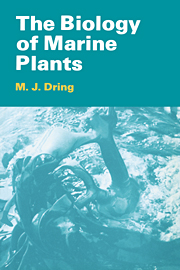Book contents
- Frontmatter
- Contents
- PREFACE
- ACKNOWLEDGEMENTS
- 1 MARINE PLANTS: TAXONOMIC, MORPHOLOGICAL AND ECOLOGICAL CATEGORIES
- 2 THE SEA AS AN ENVIRONMENT FOR PLANT GROWTH
- 3 PHOTOSYNTHESIS IN THE SEA
- 4 GROWTH AND PRODUCTIVITY OF MARINE PLANTS
- 5 MORPHOGENESIS OF MARINE PLANTS
- 6 THE ECOLOGY OF SEAWEEDS: ZONATION AND SUCCESSION
- 7 GEOGRAPHICAL DISTRIBUTION OF MARINE PLANTS
- 8 USES AND USAGE OF MARINE PLANTS
- 9 BACTERIA AND FUNGI IN THE SEA
- REFERENCES
- INDEX
4 - GROWTH AND PRODUCTIVITY OF MARINE PLANTS
Published online by Cambridge University Press: 02 February 2010
- Frontmatter
- Contents
- PREFACE
- ACKNOWLEDGEMENTS
- 1 MARINE PLANTS: TAXONOMIC, MORPHOLOGICAL AND ECOLOGICAL CATEGORIES
- 2 THE SEA AS AN ENVIRONMENT FOR PLANT GROWTH
- 3 PHOTOSYNTHESIS IN THE SEA
- 4 GROWTH AND PRODUCTIVITY OF MARINE PLANTS
- 5 MORPHOGENESIS OF MARINE PLANTS
- 6 THE ECOLOGY OF SEAWEEDS: ZONATION AND SUCCESSION
- 7 GEOGRAPHICAL DISTRIBUTION OF MARINE PLANTS
- 8 USES AND USAGE OF MARINE PLANTS
- 9 BACTERIA AND FUNGI IN THE SEA
- REFERENCES
- INDEX
Summary
The growth of natural populations of both animals and plants is extremely difficult to measure under natural conditions. For animals, there is no alternative but to estimate the growth rate — for one species at a time — from changes in numbers and weights of individuals in the field, allowing for losses resulting from predation and death. For photosynthetic plants, however, it is possible — and very much easier — to estimate the overall productivity of all of the species in an ecosystem by measuring the uptake or release of inorganic chemicals (e.g. CO2, O2, NO-3 + NH+4) in the environment, and most attention has been concentrated on this approach. These rates of exchange of inorganic chemicals between plants and their environment are correlated with the rates of individual processes that contribute to growth, such as photosynthesis and ion uptake, rather than with growth rate itself, and direct studies of plant growth in the sea have been largely restricted to a few species, mainly kelps, which are particularly convenient for such work (see p. 83). It is, therefore, important to examine the relationships between photosynthesis, nutrient uptake and growth, as revealed by laboratory experiments, before attempting to interpret the seasonal and geographical variations of plant biomass and primary productivity in the sea.
NUTRIENT UPTAKE
Requirements for growth
The algae are physiologically more diverse than vascular plants, and this diversity is reflected in their nutrient requirements.
- Type
- Chapter
- Information
- The Biology of Marine Plants , pp. 67 - 91Publisher: Cambridge University PressPrint publication year: 1991



